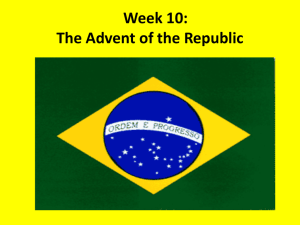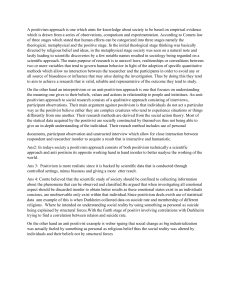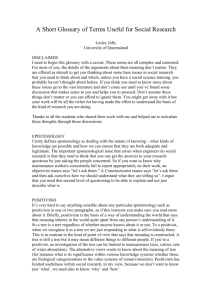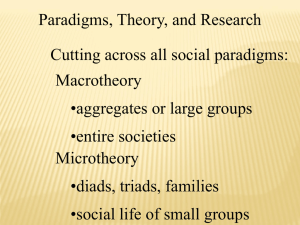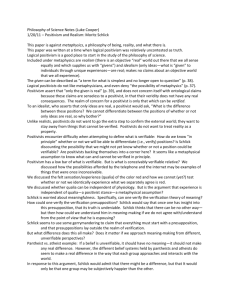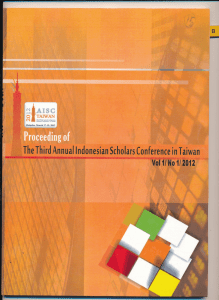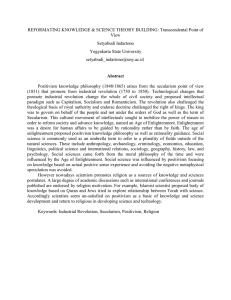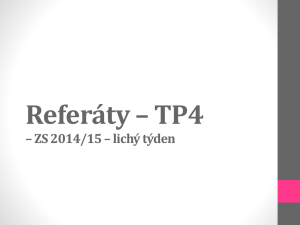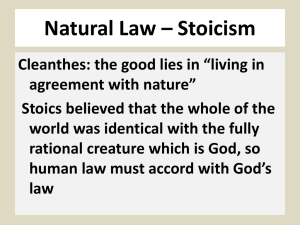Welcome back! Week 1: “Coffee with Milk”: The First Republic, 1889-1930
advertisement
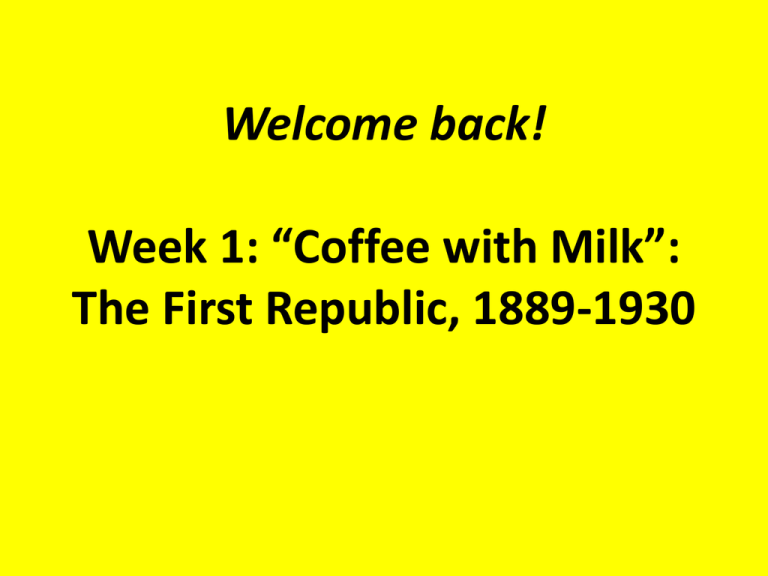
Welcome back! Week 1: “Coffee with Milk”: The First Republic, 1889-1930 Marshall Deodoro da Fonseca Themes for this week • Ideological currents – especially Positivism • Political structures underpinning the Republic • Tensions between military and civilians in politics • Was the Republic consented to/ challenged/ participated in by non-elite Brazilians? • Did 1889 represent change or continuity? Ideological shifts: Positivism • A philosophy, and indeed later a whole RELIGION, founded by French philosopher August Comte from 1847 • The notion that mankind will advance through SCIENCE AND PROGRESS; The Republican flag Three main “stages” of human progress • 1: theological stage: world understood in religious terms, roughly equates to preEnlightenment • 2: metaphysical stage: humanity uses observation and rational thought to understand the world; roughly equivalent to Enlightenment • 3: positivist stage: full understanding of world and natural laws will be achieved by all humanity; no war; no nations; no distinctions between humans Positivist church, Rio de Janeiro “Order and Progress” • “Progress” (broadly defined) to be achieved through “order”, ie: • NOT through any radical or popular process, but LED BY A SMALL SELECT GROUP who are suited to the task. • Comte develops positivism as response to French Revolution • Modernisation without democracy – a “conservative” strain of Liberalism? Positivist contradictions… • Positivism embraced by army (Military Academy in Rio under Benjamin Constant); YET: • Orthodox positivists don’t believe in armies… • Eventual army split between intellectual positivists and pragmatic “Young Turks” (emphasise military science and war) Practical implications of positivism • Associations with republicanism and with the generation that help oust the monarchy • Positivism embraces humanity instead of God: associated with anticlericalism; positivists clash with the Catholic Church under Republic • “Progress” embraced feverishly by Brazilian elites: allow Brazil to take its place on the world stage… Urban reforms • Major reforms of the cities that showcase Brazil to foreign eyes, especially Rio de Janeiro • Construction of major avenues e.g. Avenida Central • New impressive buildings e.g. Municipal Theatre • Violent slum clearances from city centre; new marginal areas and favelas spring up • Public health campaigns against e.g. yellow fever, Chagas disease... • sparks Vaccine Riot in Rio in 1904 Positivism and race • Orthodox positivism DOESN’T embrace “scientific racism,” BUT: • In practice “progress” ends up being defined in RACIAL terms • EUROPE as synonymous with “progress”, yet whites still outnumbered by non-whites by 1890. • Fashionable doctrines of scientific racism (non-whites are lower down on an evolutionary scale of progress). • Solutions: whitening through racial mixing; European immigration; migration from Africa banned • Significant demographic implications Conquering the interior • “Progress” as conquest of unknown interior • E.g. telegraph campaigns of Rondon (positivist military officer): incorporate/ convert the indigenous • E.g. Euclides da Cunha (expedition to Canudos in 1890s, conquest of the “backlands) Political structures • • • • Church disestablished New constitution (1891) Monarchy replaced by elected presidents Swing towards federalism. Provinces become states. Increased powers to raise taxes; differing economic development • Dominance of São Paulo and Minas Gerais (“coffee with milk” alliance) Political structures (2) • Literacy qualification restricts franchise (although no property qualification) • Dominance of coronéis (local political bosses) increases • Politics managed by patronage, force and favour, electoral party machines • Ruling party almost always wins elections • Party differences more factional than ideologcial Increased role of the military • Initial military rule (1889-1894); then civilian rule • But: military as active political agent; arbiter of disputes • Multiple military risings/ coup attempts, eg: • 1891 coup attempt and revolt in Rio Grande do Sul helps usher in Floriano Peixoto; • series of military uprisings against Floriano’s regime from 1891 • 1904 coup plot linked to vaccine revolt in Rio • Naval revolt in 1910: “Revolt of the Lash” Economy • Dominance of coffee: 5.5M sacks in 1890-1; over 16M in 1901-2; 75% of world’s coffee produced by Brazil at turn of century • Vulnerable to changes in world market • 1906 Taubaté agreement: measures to protect coffee • Brief rubber boom in Amazon, 1900-1910… Rubber boom: Belém opera house Industry and immigration • Government not promoting industrialisation. Industry = only 10% of GDP in 1900 • But some industrialisation nonetheless…mainly in South-East • Coffee economy stimulates other sectors: banking, imports/ exports, rail… • Industry fuelled by European immigrants: over 1.2M arrive in 1890s… • In 1900, 92% of industrial workers in SP were immigrants • Nearly 3M immigrants arrive, 1884-1920: “melting-pot” of cultures • Southern Europeans: anarchism and socialism; trades unions slowly emerge… • Brazilian communist party founded 1922 Arrival of Italian immigrants in Sao Paulo Questions for the seminar… • How much changed under the Republic? Who were the winners and losers? • What was the role of coffee economically and politically? • How did ordinary people respond to life under the Republic? • How did Republicans and Positivists view AfroBrazilians? With what implications?
